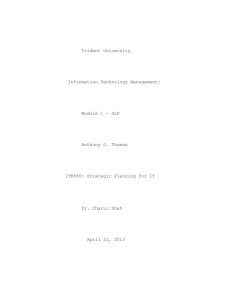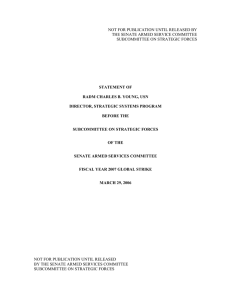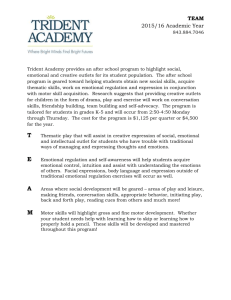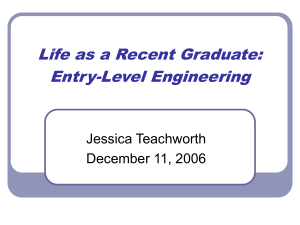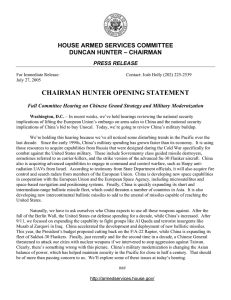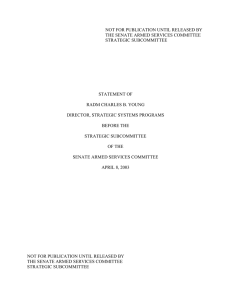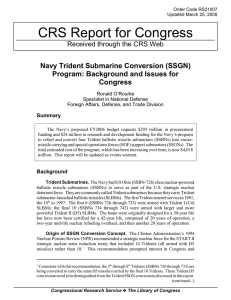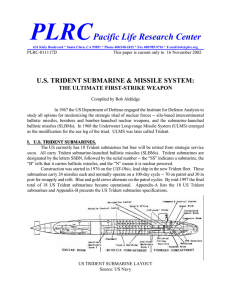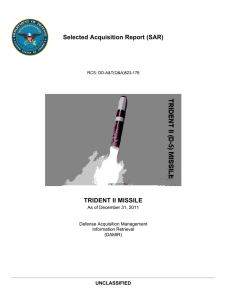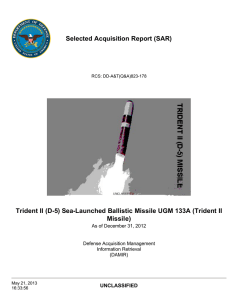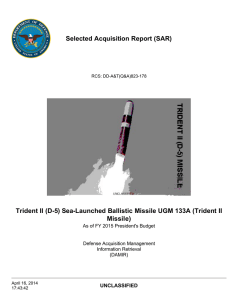NOT FOR PUBLICATION UNTIL RELEASED BY THE SENATE ARMED SERVICES COMMITTEE
advertisement
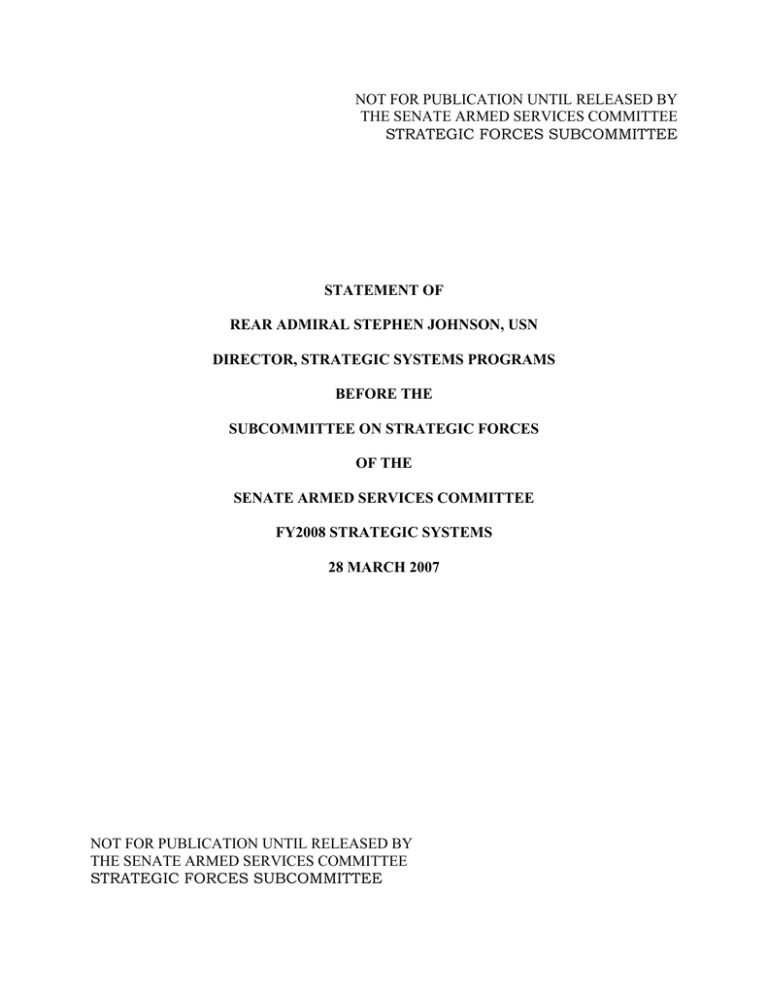
NOT FOR PUBLICATION UNTIL RELEASED BY THE SENATE ARMED SERVICES COMMITTEE STRATEGIC FORCES SUBCOMMITTEE STATEMENT OF REAR ADMIRAL STEPHEN JOHNSON, USN DIRECTOR, STRATEGIC SYSTEMS PROGRAMS BEFORE THE SUBCOMMITTEE ON STRATEGIC FORCES OF THE SENATE ARMED SERVICES COMMITTEE FY2008 STRATEGIC SYSTEMS 28 MARCH 2007 NOT FOR PUBLICATION UNTIL RELEASED BY THE SENATE ARMED SERVICES COMMITTEE STRATEGIC FORCES SUBCOMMITTEE Chairman Nelson, Senator Sessions, distinguished members of the Strategic Forces Subcommittee. Thank you for the opportunity to appear before you to discuss the Navy’s efforts to maintain the credibility of our strategic deterrent forces. Strategic Systems Programs (SSP) is responsible for maintaining our currently deployed Trident II forces and to develop capabilities which will support future requirements of our Combatant Commanders. The Navy’s operational strategic deterrent fleet continues to provide a credible and affordable deterrent against nuclear war. Our Trident II weapons system, comprised of 14 submarines, 6 in the Atlantic fleet and 8 in the Pacific fleet, is maintaining a reliable sea based deterrent for our national leadership. Two of our submarines are undergoing engineering refueling overhauls (ERO). Along with USS Alabama (SSBN-731), which began her overhaul last year at Puget Sound Naval Shipyard, USS Alaska (SSBN-732) has commenced her ERO at Norfolk Naval Shipyard. Three SSGNs have returned to operation, USS Ohio (SSGN-726), USS Florida (SSGN-728) and USS Michigan (SSGN 727). USS Georgia (SSGN-729), the fourth SSGN, is expected to complete her conversion in September 2007. D5 Life Extension TRIDENT II (D5) Submarine Launched Ballistic Missile Life Extension (LE) program will redesign and replace aging missile electronics and guidance systems. Under this program, 108 additional missiles will be procured in order to meet long-term inventory requirements associated with the life extension of the OHIO class SSBN. Redesign of missile electronics and guidance components is in progress, and procurement of new D5 LE missiles begins in FY08. The TRIDENT II (D5) missile has been operational since 1990, providing the backbone of America’s strategic deterrence. The low-rate production continuity procurement strategy has 2 been extensively reviewed and approved by DoD and the Congress, and has been in execution for nearly 15 years. This procurement strategy has been proven successful, based on the demonstrated performance of the TRIDENT II D5 weapon system. The Navy submitted a report to Congress in December 2002 that detailed the impact of alternative full-funded procurement strategies and recommended continuation of current production. Continued production of critical components represents the best balance of cost and risk to extend the life of the D5 missile. Nuclear Weapons Security One of our most important responsibilities is maintaining security over the ships and missiles in the Trident Program. Our budget submit includes elements to improve this security posture, including sensored perimeter fencing, waterfront intruder detection systems, and hardened security force facilities and vehicles, as well as a secure command and control network. The roadmap to implement these nuclear weapons security elements over the FYDP was recently briefed to the VCNO and JROC, and execution is underway. The SSBN Transit Protection Program extends the security umbrella to cover SSBNs transiting between piers and dive points. Reliable Replacement Warhead The Navy and the National Nuclear Security Administration (NNSA) have recently started a joint program to design a replacement warhead for a portion of the Nation’s sea-based nuclear weapons used in submarine launched ballistic missiles. This replacement warhead will not require underground testing. Other key aspects of this program include designing 3 replacement warheads that are more efficient to manufacture, are safer and more secure, elimination of environmentally hazardous materials, and increased design performance margins, thus ensuring long-term confidence in reliability. The Nuclear Weapon’s Council, a joint body including DOE and DOD, endorsed NNSA’s recommendation for the Lawrence Livermore/Sandia design as the baseline for the RRW-1 program. However, several features of the Los Alamos/Sandia design are of great interest and they will be developed in parallel to the Lawrence Livermore National Laboratory effort. If sufficiently mature, these design enhancements will be incorporated into the baseline design at the appropriate development step. The selection of the Lawrence Livermore National Laboratory’s baseline design was the first step toward detailed design of a reliable replacement warhead. NNSA and the Navy will now work together to develop a detailed RRW project plan and cost estimate for developing and producing the system. The RRW Project Officer Group, led by the Navy, will present the results of a design definition and cost study to the Nuclear Weapons Council for approval later this year, at which time authorization to proceed to detailed design and system development will be requested. Conventional Trident Modification The Conventional Trident Modification, or CTM, is the only near-term solution which can provide prompt, precise, conventional kinetic effects at intercontinental ranges. Given the requested resources, we can deliver the initial capability early in 2010, much earlier than any other alternative approach. CTM adapts the Trident II (D5) missile system to deliver conventional (non-nuclear) effects at global ranges. The Trident Weapon System and the D5 missile are well suited for this 4 role by virtue of the long range and payload capacity of the D5 missile, and the responsiveness and survivability of the Trident Weapon System. Responsive, survivable and persistent, CTM will defeat a diverse set of unpredictable threats without visible presence or risk to U.S. forces, and with little or no warning prior to strike. CTM implements the New Triad envisioned by the Nuclear Posture Review and is an evolution of deterrence toward conventional weapons. CTM CONOPS have been developed by USSTRATCOM. CTM will use existing D5 missiles, MK4 reentry bodies equipped with aerodynamic controls, GPS-aided terminal guidance, and a conventional warhead. Advanced error-correcting reentry vehicles with GPS-aided Inertial Navigation Systems have been flight proven in a previous D5 test program. Total time from decision to weapons-on-target is about 1 hour. CTM technology can be rapidly developed and deployed within 24 months. The FY2008 funding request for CTM is $175 million. We have frontloaded the funding profile to provide the capability to the warfighter as quickly as possible. The bulk of the request is $126 million for R&D to proceed with warhead development efforts required to achieve initial operating capability (IOC) by early 2010. The additional $49 million is procurement funding that is required for reentry body component long lead materials and shipboard systems and trainer modifications. SSGN Three of our SSGNs have already returned to service and the fourth will rejoin the fleet in about seven months. Operational tests are in progress and the first patrol is anticipated before year’s end. 5 These SSGNs are already demonstrating a transformational war fighting capability, carrying Tomahawk cruise missiles and supporting special operating forces. They have enhanced communication and improved masts and antennae for network centric operations. We are forging new relationships within the Department of the Navy and the Department of Defense in order to ensure that these submarines be used to maximum advantage in the War on Terror. Summary Mr. Chairman and distinguished members of this subcommittee, I thank you for your continued support of Strategic Systems Programs and our operational fleet in particular. Our strategic force remains a credible and reliable deterrent today. It is our goal to ensure that the Nation is protected through efforts to maintain the safety, reliability, and surety of our deployed systems. Thank you again for this opportunity to appear today to speak on behalf of Navy Strategic Systems Programs. 6
